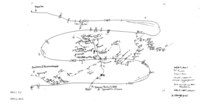What’s the Score Now?
What’s the Score Now? is an expanded publication on scores and notation systems employed in contemporary dance and performance practices from the turn of the millennium up to 2005. It’s the first publication in the framework of Oral Site.
Antonia Baehr on Scores
00:01:00 00:05:00
00:05:00 00:10:00
Jonathan Burrows on Scores
Both Sitting Duet (2002)
Both Sitting Duet is a duet made and performed by the choreographer Jonathan Burrows and the composer Matteo Fargion. The piece is performed sitting down, and both performers have their own notebook on the floor before them, visible to the audience. You will find here copies of both performer’s scores, one written in classical musical notation and the other as a series of written numbers. These scores are placed at the feet of the performers and read throughout the performance. Both Sitting Duet is a direct translation, of the violin and piano piece For John Cage by the American composer Morton Feldman.
—> More: An annotated interview of choreographer Jonathan Burrows by Myriam Van Imschoot, April 14 2005.
Vincent Dunoyer on Scores
The score of Solos for Others (2003), with an audio-comment by Vincent Dunoyer.
Thomas Lehmen on Scores
00:01:00 00:02:00
With this simple example of how we have to compose ourselves when having a conversation that I use a lot to see and to be seen, to appear to be listening at the same time of the actual effort to listen, in the sense that if I want to really listen to you it might be distracting to look at you, but that’s not that acceptable to not take the choreographic pattern of showing our attention to each other.
00:02:00 00:10:00
Amos Hetz on Scores
Unpublished text The notated Gesture (Amos Hetz, 2010), with illustrations of scores and drawings.
Myriam Gourfinck
Glossolalie (1999)
This is the first page of the score of Glossolalie. Glossolalie was a solo made for dancer Jérôme Bel. The structure of the performance was written very fast by Myriam Gourfinck and the precise instructions are aleatory decided on the evening itself. The solo was intended to give shpae to Jérôme Bel’s very personal language.
Kill The King (2005)
This is a score that was printed and layed out on the floor, visible to the audience and the solo performer, during the performance. The score is derived from Laban notation
—> More: The score of Glossolalie, annotated and audio-commented by Myriam Gourfinck.
Lisa Nelson on Scores
An interview of Lisa Nelson by Myriam Van Imschoot (29 March 2005). The interview has perforated subtitles.
Thierry De Mey on Scores
Examples of scores for Anne Theresa De Keersmaeker, with an audio-comment by Thierry De Mey.
William Forsythe on Scores
The score of Tiepolo
Introduction
What’s the score now goes back to a special edition on scores and notations in Multitudes (nr. 21, Spring 2005), a French political, philosophical and cultural journal. Curators Myriam Van Imschoot and Ludovic Burel published in that context a selection of visual materials (scores, working materials, and notation examples by different choreographers) and Van Imschoot’s essay ‘Rests in Pieces’ on the theme of scores. At the time it honed a resurgent interest in scores, as such manifested itself in the prolific work of artists and choreographers, in search of new forms of collaboration, composition, working methods and politics of spectatorship. Several demands for republication of the Multitudes’ score special over the years, may testify to the fact that their is an ongoing interest in the theme of scores. This motivated the choice to make What’s the score now the first expanded publication for Oral Site.
What’s the score now is an expanded publication, because it not only republishes the original ‘special’ that appeared in Multitudes together with more visuals and translations of the core-essay Rests in Pieces (next to French, English, Portuguese and soon to come Spanish versions). Above all, it publishes for the first time the interviews that were conducted in 2005 with 10 artists in the field of score-based performance work. Antonia Baehr, Vincent Dunoyer, William Forsythe, Jonathan Burrows & Matteo Fargion, Thomas Lehmen, Myriam Gourfink, Thierry De Mey, Lisa Nelson and Amos Hetz played a vital role during the preparation for the Multitudes issue. Originally, not meant for publication, the release of this research material, more than 6 years later, now gives insight in the intentions, motivations and concerns of the artists and in some distinctive approaches to score and notation practice in the field.
What’s the score now is a multimodal document that makes text, visuals and sound converge.
A couple of notes on the interviews
Since most of the interviews happened at home or in the archives of the interviewees, there is a concreteness to the conversations. The first purpose of the interviews was to select ‘scores’ to be published in Multitudes while developing an understanding of their use. The editors and artists browsed through the archives, handling the objects and documents. This zoom quality (from the concreteness to larger concerns) not always make the interviews an easy ‘read’ or ‘listen’, a challenge the editors of Oral Site have tried to meet with providing more contextualisation, annotation, illustration and extra bonus like new additions of interview sections.
One reason to publish rather raw material is to break open the usual formats of polished public discourse. Also, furnishing the interview material allows the visitor to arrive at alternative conclusions other than those drawn in the essay of Van Imschoot. It’s a refracturing of the subject and topic, by way of exposing the genealogy of ideas and providing research materials as building blocks within.







